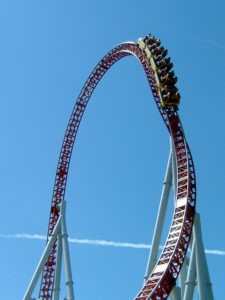Millions of American families seeking fun and thrills attend one of countless amusement parks each and every year. After all, there is something for everyone, from kiddie rides to inverted roller coasters, to novel carnival games, to funnel cakes and other “fair food,” and everything in between. Most days at the amusement park produce lasting memories that families look back on fondly. Sometimes, however, a day of expected laughter and joy rides turns tragic and dark.
What most Americans don’t recognize is the relative danger posed by many common attractions at amusement parks.
Amusement Park Injury Statistics
 Thousands of innocent park-goers are injured every year due to malfunctions on rides, poor judgment by park personnel, or the hazardous conditions that parks fail to fix or warn attendees about. The National Consumer Product Safety Commission reports over 7,000 people were hospitalized due to injuries sustained at amusement parks in 2015 alone. This figure does not include what is likely thousands of injuries not requiring hospitalization, or not otherwise reported.
Thousands of innocent park-goers are injured every year due to malfunctions on rides, poor judgment by park personnel, or the hazardous conditions that parks fail to fix or warn attendees about. The National Consumer Product Safety Commission reports over 7,000 people were hospitalized due to injuries sustained at amusement parks in 2015 alone. This figure does not include what is likely thousands of injuries not requiring hospitalization, or not otherwise reported.
The severity of amusement park injuries has increased dramatically in recent years as rides become more technologically advanced, and are built with ever-increasing speed and height. On August 7, 2016, a 10-year old boy was killed while riding “the world’s tallest waterslide” at Schlitterbahn Water Park in Kansas City, Kansas. After climbing 264 stairs to the top passengers plummet down a steep 17 story drop.
The Verruckt waterslide (German for “Insane”) boasts a top speed of 65 MPH and has protective netting that encapsulates the ride to prevent riders from flying off. The park added the netting after early test runs showed the rafts could become disconnected from the slide’s surface, thereby launching the raft (and potential passengers) air-born. Riders are strapped onto their raft using Velcro straps. Evidence also indicates the park received numerous reports from riders claiming their straps came undone mid-ride, yet no adjustments were made.
Amusement Parks Aren’t the Only Offenders
 Unfortunately, incidents are not limited to major amusement parks. Two days after the incident that left a young boy dead in Kansas City, 3 young girls plummeted from a Ferris wheel in Tennessee at a local fair. The girls fell approximately 35 feet to the ground after hitting numerous spokes and carousels on their way down. All three were hospitalized, one for critical and life-threatening injuries. Inspectors cleared the ride of any safety violations just two months prior. Mechanical failure, in addition to negligent design, can lead to serious injuries from such attractions.
Unfortunately, incidents are not limited to major amusement parks. Two days after the incident that left a young boy dead in Kansas City, 3 young girls plummeted from a Ferris wheel in Tennessee at a local fair. The girls fell approximately 35 feet to the ground after hitting numerous spokes and carousels on their way down. All three were hospitalized, one for critical and life-threatening injuries. Inspectors cleared the ride of any safety violations just two months prior. Mechanical failure, in addition to negligent design, can lead to serious injuries from such attractions.
Amusement park injuries are not limited to modern-day, technologically advanced attractions. A three-year-old boy was injured when he fell from a 78-year-old roller coaster at a park outside Pittsburgh, Pennsylvania just two days removed from the Ferris wheel accident in Tennessee. The child was airlifted by helicopter from the scene. The ride requires passengers to be at least 48 inches tall but allows passengers just 36 inches tall to ride if they are accompanied by an adult.
What Does the Research Say?
 Medical research and psychological studies show young children often become frightened from amusement park attractions, and lack the mental capacity to comprehend the risk of removing themselves from the ride while in operation. Their instinct tells them to get off the ride as quickly as possible because the ride represents the cause of their fear. Children simply lack an appreciation for the risk involved with removal from a high-speed vehicle, and older rides often have less restrictive safety measures and can be more easily manually manipulated by the rider, especially small, younger children who can “climb out” or squeeze through the safety mechanism.
Medical research and psychological studies show young children often become frightened from amusement park attractions, and lack the mental capacity to comprehend the risk of removing themselves from the ride while in operation. Their instinct tells them to get off the ride as quickly as possible because the ride represents the cause of their fear. Children simply lack an appreciation for the risk involved with removal from a high-speed vehicle, and older rides often have less restrictive safety measures and can be more easily manually manipulated by the rider, especially small, younger children who can “climb out” or squeeze through the safety mechanism.
There are no federal regulations for amusement park rides. Records indicate the Verruckt waterslide had not been inspected by the state since it opened more than two years prior to the accident. When regulation does occur, it is often by untrained and inexperienced local personnel who lack the requisite skill required to effectively ensure passenger safety. The types of regulations employed by states vary considerably.
Twenty-four states have comprehensive government inspection and accident investigation programs in place to try and reduce the number of amusement park injuries by conducting regular inspections and safety recommendations. Eleven states have very minimal statutory requirements regarding amusement park operation and safety, and leave the vast majority of discretion to the private sector. Nine states, including Missouri and Kansas, have partial oversight. These states have some regulations and requirements but still, leave many safety and operational decisions to the parks themselves. Incredibly, six states have no regulations at all relating to amusement park safety.
What the Parks Have to Say
 The International Association of Amusement Parks and Attractions claims safety is their top priority, and recently issued a statement claiming “there is no evidence federal oversight would improve on the already excellent safety record of the industry,” all leading to the question: What constitutes an excellent safety record? With no formal federal guidelines or protocols to dictate what an adequate or sufficient safety record should look like, the industry apparently self-defines an excellent safety record as 7,000 injuries per year are severe enough to require a visit to the emergency room.
The International Association of Amusement Parks and Attractions claims safety is their top priority, and recently issued a statement claiming “there is no evidence federal oversight would improve on the already excellent safety record of the industry,” all leading to the question: What constitutes an excellent safety record? With no formal federal guidelines or protocols to dictate what an adequate or sufficient safety record should look like, the industry apparently self-defines an excellent safety record as 7,000 injuries per year are severe enough to require a visit to the emergency room.
These tragic stories are but a few examples of how a beautiful day at the amusement park or county fair can turn into a living nightmare for children and parents. Advancements in technology and an increasing desire among parks to give thrill-seekers the next big thing, combined with little to no government regulation, virtually ensure injuries will continue to occur. So, if you are thinking of taking your children, family, and friends to the amusement park, here are a few quick tips for ensuring your loved one’s safety:
- If a child tells you he or she is scared or shows signs of not wanting to get on the ride, support that decision. Be understanding and don’t force children into situations where they may feel uncomfortable. It’s always ok to “sit this one out.”
- Always follow all posted height, age, weight, and health restrictions, but don’t blindly trust the park’s recommendations. These requirements are only suggested guidelines to ensure safety. Use common sense and your own best judgment.
- Speak up. If you think your safety belt is loose or your child’s harness is not working properly, notify the ride attendant and seek assistance from those who know the ride best. If something goes wrong mid-ride, again, let the attendant know so that they can either take that cart/shuttle out of commission, notify their supervisor, or ensure no other passenger sits in that seat until further inspections can be made.
- Never go into a Restricted Area. That area is marked off for a reason. If you lose your hat or drop your car keys, notify the ride attendant. They can stop the ride momentarily and retrieve your items for you to ensure your safety.
- Avoid wearing loose clothing or items that dangle or hang off your person. These items can hook or snag on parts of the ride, and create unnecessary risk.
- Listen, and follow all ride instructions. The park wants to make sure all passengers have a fun, but safe experience.
Amusement parks and their attractions are an American tradition and pastime dating back over 100 years. So by all means, get out there and enjoy the thrills and chills with your family and friends, but do your best to avoid the spills. By implementing a few quick and easy steps you can further ensure your family’s safety when visiting amusement parks, leaving you free to simply sit back and enjoy the ride.
